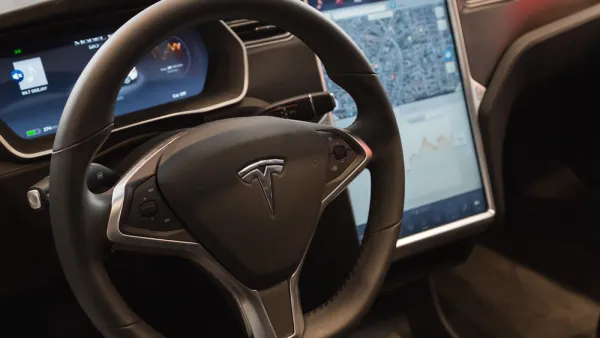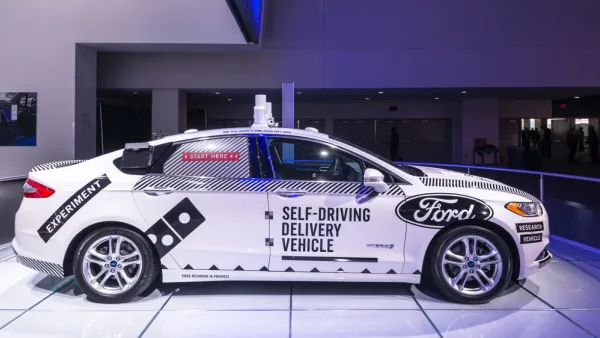A new report from Urbanism Next/SCI takes you through a city’s budget—both revenues and expenditures—and describes the areas that will be affected as AVs become commonplace and e-commerce takes on an even larger role in retail

Could autonomous vehicles and E-commerce cause an economic disaster for government? Knowing about the possible impacts of technological disruption can help government prepare.
In July 2017, Urbanism Next, a research project sponsored by the Sustainable Cities Initiative, explored one of the secondary effects of AVs and e-commerce on communities—the impacts on local government budgeting and finance.
The resulting report, ‘The Impact of AVs and E-Commerce on Local Government Budgeting and Finance’, surveys a city’s budget—both revenues and expenditures—and starts to think about what could happen as AVs become common and e-commerce takes on an even larger role in retail. City leaders have to start planning for this future now if they want to have a voice in what AVs and e-commerce will do to their cities. AVs create a “potential rat’s nest of a budgeting challenge.” This report seeks to begin the process of untangling that rat’s nest, and provide the foundation for future phases of the project that will consider potential additional revenue sources to fund the infrastructure changes that may come from the integration of AVs and more widespread e-commerce.
Consider that AVs will be on the roads in substantial numbers within the next 10 years, and taking on a substantial share of transportation needs in 20 (or less). Uber didn’t exist before 2009, but by 2017 nearly 10% of people who sold their cars last year are doing it because they just use Uber and Lyft instead. As the technology gets simpler and pricing goes down, more and more people will find alternative ways to getting around than owning their own car.
E-commerce promises to be equally disruptive to retail. When Amazon started in the 1990s, no one could have imagined that the online bookstore would transform into one of the world’s largest companies. Now, about half of all American households have an Amazon Prime account and brick and mortar stores across the country are struggling to compete. More stores are closing today than during the Great Recession, emptying out commercial corridors and shopping malls.
The combination of e-commerce and AVs will (and may already be) reshaping our cities and this transformation will affect everyone. Many cities have large investments in on-street parking and parking garages built with bonds to be repaid by future parking revenue. However, that revenue might not materialize as more and more people use ridesharing and AV services instead of their own cars. Already, airports have seen a substantial drop off in parking revenue, taxi revenues, and rental car revenues because of the increase in ridesharing services.
The report explores the impacts of technology on a range of taxes, including property, business, and sales use taxes, as well as fee for service. It also raises a number of equity issues, considering that many jobs, such as bus drivers, parking enforcement, and court personnel that handle traffic citations may shed jobs as they are replaced by AVs or there is less demand because of a lack of parking and enforcement of traffic laws.
Read the full report here.
FULL STORY: The Impact of AVs and E-Commerce on Local Government Budgeting and Finance

National Parks Layoffs Will Cause Communities to Lose Billions
Thousands of essential park workers were laid off this week, just before the busy spring break season.

Retro-silient?: America’s First “Eco-burb,” The Woodlands Turns 50
A master-planned community north of Houston offers lessons on green infrastructure and resilient design, but falls short of its founder’s lofty affordability and walkability goals.

Delivering for America Plan Will Downgrade Mail Service in at Least 49.5 Percent of Zip Codes
Republican and Democrat lawmakers criticize the plan for its disproportionate negative impact on rural communities.

Test News Post 1
This is a summary

Test News Headline 46
Test for the image on the front page.

Balancing Bombs and Butterflies: How the National Guard Protects a Rare Species
The National Guard at Fort Indiantown Gap uses GIS technology and land management strategies to balance military training with conservation efforts, ensuring the survival of the rare eastern regal fritillary butterfly.
Urban Design for Planners 1: Software Tools
This six-course series explores essential urban design concepts using open source software and equips planners with the tools they need to participate fully in the urban design process.
Planning for Universal Design
Learn the tools for implementing Universal Design in planning regulations.
EMC Planning Group, Inc.
Planetizen
Planetizen
Mpact (formerly Rail~Volution)
Great Falls Development Authority, Inc.
HUDs Office of Policy Development and Research
NYU Wagner Graduate School of Public Service





























